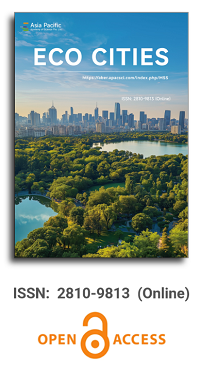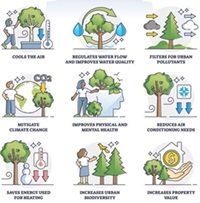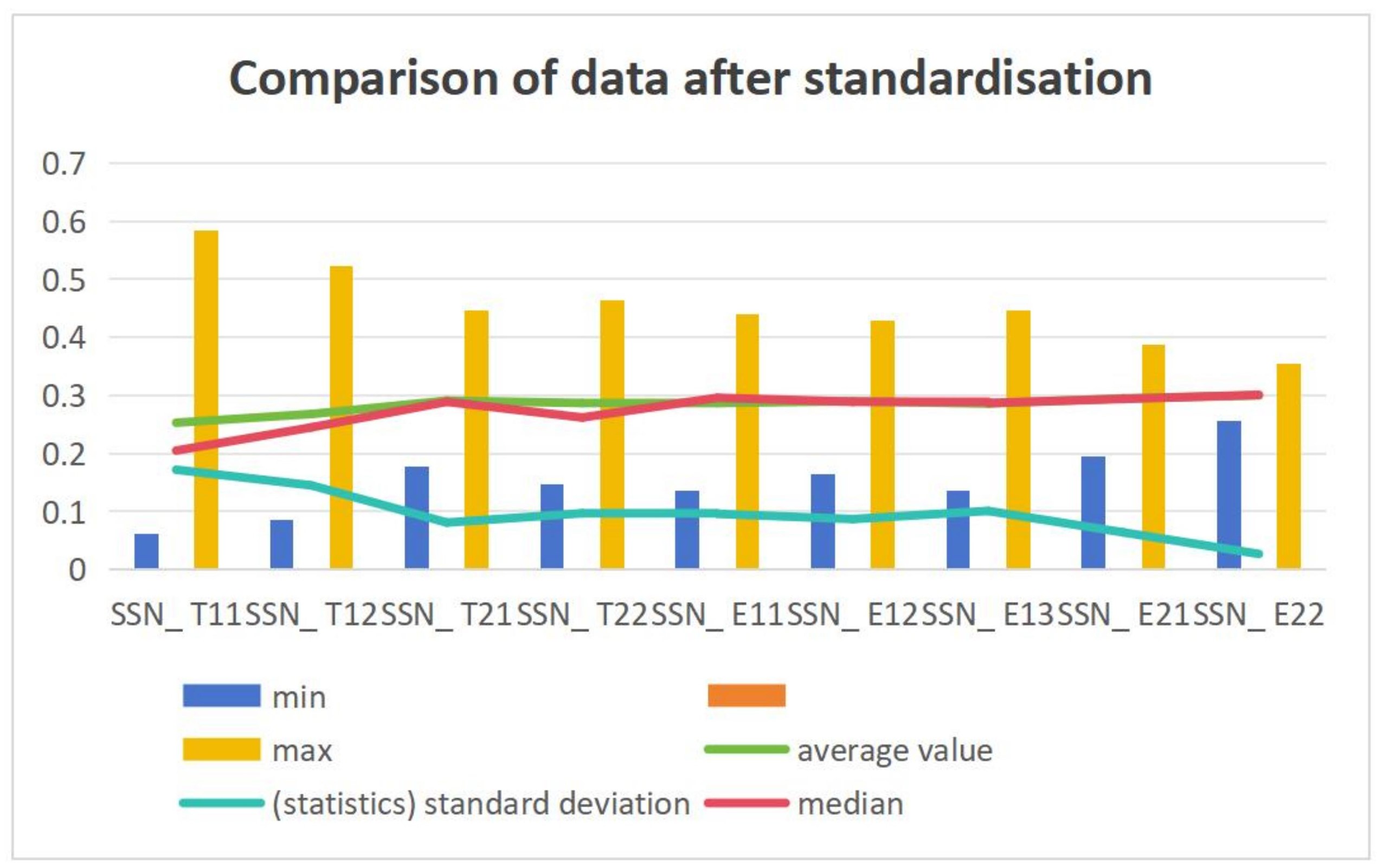


Improving indoor temperatures through a homemade green roof modular system
Vol 6, Issue 1, 2025
Download PDF
Abstract
Increased urbanisation has led to a worsening in the quality of life for people in large cities due to the increase in indoor temperatures. Retrofitted green roofs may attenuate housing temperatures, due to the isolation and passive cooling properties of these vegetated systems. For this purpose, this research reports on an experiment using a green roof modular system to compare indoor and outdoor temperatures before, and after, a green roof set up in an existing depot in Rio de Janeiro, Brazil characterized by high temperatures for most parts of the year. The modular system comprised previously used pallets covered with geotextile and planted with succulent species with low watering needs and reduced maintenance processes. Compared to the outdoor environment, mostly warmer indoor conditions were converted to cooler temperatures and due to its thermal properties, which provide insulation, evapotranspiration, and shading the green roof system presented a potential to attenuate the heat exchange and improve indoor conditions. A homemade lightweight modular system can widespread green roofs on a city scale.
Keywords
References
- Heaviside C, Macintyre H, Vardoulakis S. The Urban Heat Island: Implications for Health in a Changing Environment. Current Environmental Health Reports. 2017; 4(3): 296–305. doi: 10.1007/s40572-017-0150-3
- Gronlund CJ, Zanobetti A, Schwartz JD, et al. Heat, Heat Waves, and Hospital Admissions among the Elderly in the United States, 1992–2006. Environmental Health Perspectives. 2014; 122(11): 1187–1192. doi: 10.1289/ehp.1206132
- Hondula DM, Barnett AG. Heat-Related Morbidity in Brisbane, Australia: Spatial Variation and Area-Level Predictors. Environmental Health Perspectives. 2014; 122(8): 831–836. doi: 10.1289/ehp.1307496
- Ye X, Wolff R, Yu W, et al. Ambient Temperature and Morbidity: A Review of Epidemiological Evidence. Environmental Health Perspectives. 2012; 120(1): 19–28. doi: 10.1289/ehp.1003198
- Susca T, Gaffin SR, Dell’Osso GR. Positive effects of vegetation: Urban heat island and green roofs. Environmental Pollution. 2011; 159(8–9): 2119–2126. doi: 10.1016/j.envpol.2011.03.007
- Herrera-Gomez SS, Quevedo-Nolasco A, Pérez-Urrestarazu L. The role of green roofs in climate change mitigation. A case study in Seville (Spain). Building and Environment. 2017; 123: 575–584. doi: 10.1016/j.buildenv.2017.07.036
- Castleton HF, Stovin V, Beck SBM, et al. Green roofs; building energy savings and the potential for retrofit. Energy and Buildings. 2010; 42(10): 1582–1591. doi: 10.1016/j.enbuild.2010.05.004
- Jamei E, Thirunavukkarasu G, Chau HW, et al. Investigating the cooling effect of a green roof in Melbourne. Building and Environment. 2023; 246: 110965. doi: 10.1016/j.buildenv.2023.110965
- Adilkhanova I, Santamouris M, Yun GY. Green roofs save energy in cities and fight regional climate change. Nature Cities. 2024; 1(3): 238–249. doi: 10.1038/s44284-024-00035-7
- Solcerova A, van de Ven F, Wang M, et al. Do green roofs cool the air? Building and Environment. 2017; 111: 249–255. doi: 10.1016/j.buildenv.2016.10.021
- Pastore L, Corrao R, Heiselberg PK. The effects of vegetation on indoor thermal comfort: The application of a multi-scale simulation methodology on a residential neighborhood renovation case study. Energy and Buildings. 2017; 146: 1–11. doi: 10.1016/j.enbuild.2017.04.022
- Ouldboukhitine SE, Belarbi R, Djedjig R. Characterization of green roof components: Measurements of thermal and hydrological properties. Building and Environment. 2012; 56: 78–85. doi: 10.1016/j.buildenv.2012.02.024
- Alcazar S, Bass B. Energy performance of green roofs in a multi storey residential building in Madrid. Greening Rooftops for Sustainable Communities. Washington DC; 2005.
- Zheng X, Yang Z, Yang J, et al. An experimental study on the thermal and energy performance of self-sustaining green roofs under severe drought conditions in summer. Energy and Buildings. 2022; 261: 111953. doi: 10.1016/j.enbuild.2022.111953
- Wei T, Jim CY, Chen Y, et al. Complementary influence of green-roof and roof-slab thermal conductivity on winter indoor warming assessed by finite element analysis. Energy Reports. 2022; 8: 14852–14864. doi: 10.1016/j.egyr.2022.11.019
- López-Silva DV, Méndez-Alonzo R, Sauceda-Carvajal D, et al. Experimental comparison of two extensive green roof designs in Northwest Mexico. Building and Environment. 2022; 226: 109722. doi: 10.1016/j.buildenv.2022.109722
- Saifi N, Belatrache D, Dadamoussa A, et al. Effects of green roofs and vertical greenery systems on building thermal comfort in dry climates: an experimental study. Journal of Building Pathology and Rehabilitation. 2023; 8(1). doi: 10.1007/s41024-023-00282-6
- Borràs JG, Lerma C, Mas Á, et al. Energy Efficiency Evaluation of Green Roofs as an Intervention Strategy in Residential Buildings in the Field of Spanish Climate. Buildings. 2022; 12(7): 959. doi: 10.3390/buildings12070959
- Fleck R, Gill RL, Saadeh S, et al. Urban green roofs to manage rooftop microclimates: A case study from Sydney, Australia. Building and Environment. 2022; 209: 108673. doi: 10.1016/j.buildenv.2021.108673
- Niachou A, Papakonstantinou K, Santamouris M, et al. Analysis of the green roof thermal properties and investigation of its energy performance. Energy Build. 2001; 33: 719–29.
- Aboelata A, Sodoudi S. Evaluating urban vegetation scenarios to mitigate urban heat island and reduce buildings’ energy in dense built-up areas in Cairo. Building and Environment. 2019; 166: 106407. doi: 10.1016/j.buildenv.2019.106407
- Bevilacqua P, Mazzeo D, Arcuri N. Thermal inertia assessment of an experimental extensive green roof in summer conditions. Building and Environment. 2018; 131: 264–276. doi: 10.1016/j.buildenv.2017.11.033
- Chowdhury S, Hamada Y, Shabbir Ahmed K. Indoor heat stress and cooling energy comparison between green roof (GR) and non-green roof (n-GR) by simulations for labor intensive factories in the tropics. International Journal of Sustainable Built Environment. 2017; 6(2): 449–462. doi: 10.1016/j.ijsbe.2017.09.001
- Lin YJ, Lin HT. Thermal performance of different planting substrates and irrigation frequencies in extensive tropical rooftop greeneries. Building and Environment. 2011; 46(2): 345–355. doi: 10.1016/j.buildenv.2010.07.027
- Fang CF. Evaluating the thermal reduction effect of plant layers on rooftops. Energy and Buildings. 2008; 40(6): 1048–1052. doi: 10.1016/j.enbuild.2007.06.007
- Collins S, Kuoppamäki K, Kotze DJ, et al. Thermal behavior of green roofs under Nordic winter conditions. Building and Environment. 2017; 122: 206–214. doi: 10.1016/j.buildenv.2017.06.020
- Morakinyo TE, Dahanayake KWDKalaniC, Ng E, et al. Temperature and cooling demand reduction by green-roof types in different climates and urban densities: A co-simulation parametric study. Energy and Buildings. 2017; 145: 226–237. doi: 10.1016/j.enbuild.2017.03.066
- Squier M, Davidson CI. Heat flux and seasonal thermal performance of an extensive green roof. Building and Environment. 2016; 107: 235–244. doi: 10.1016/j.buildenv.2016.07.025
- Ouldboukhitine SE, Belarbi R, Jaffal I, et al. Assessment of green roof thermal behavior: A coupled heat and mass transfer model. Building and Environment. 2011; 46(12): 2624–2631. doi: 10.1016/j.buildenv.2011.06.021
- Wong NH, Cheong DKW, Yan H, et al. The effects of rooftop garden on energy consumption of a commercial building in Singapore. Energy Build. 2003; 35(4): 353–64.
- Czemiel Berndtsson J. Green roof performance towards management of runoff water quantity and quality: A review. Ecological Engineering. 2010; 36(4): 351–360. doi: 10.1016/j.ecoleng.2009.12.014
- Mihalakakou G, Souliotis M, Papadaki M, et al. Green roofs as a nature-based solution for improving urban sustainability: Progress and perspectives. Renewable and Sustainable Energy Reviews. 2023; 180: 113306. doi: 10.1016/j.rser.2023.113306
- Galbrun L, Scerri L. Sound insulation of lightweight extensive green roofs. Building and Environment. 2017; 116: 130–139. doi: 10.1016/j.buildenv.2017.02.008
- Kader SA, Spalevic V, Dudic B. Feasibility study for estimating optimal substrate parameters for sustainable green roof in Sri Lanka. Environment, Development and Sustainability. 2022; 26(1): 2507–2533. doi: 10.1007/s10668-022-02837-y
- Arkar C, Domjan S, Medved S. Heat transfer in a lightweight extensive green roof under water-freezing conditions. Energy and Buildings. 2018; 167: 187–199. doi: 10.1016/j.enbuild.2018.02.056
- Kostadinović D, Jovanović M, Bakić V, et al. Mitigation of urban particulate pollution using lightweight green roof system. Energy and Buildings. 2023; 293: 113203. doi: 10.1016/j.enbuild.2023.113203
- Salvalai G, Marrone G, Maria Sesana M, et al. Lightweight extensive green roof for building renovation: Summer performance analysis and application in a living laboratory. Energy and Buildings. 2023; 298: 113589. doi: 10.1016/j.enbuild.2023.113589
- Blanusa T, Vaz Monteiro MM, Fantozzi F, et al. Alternatives to Sedum on green roofs: Can broad leaf perennial plants offer better ‘cooling service’? Building and Environment. 2013; 59: 99–106. doi: 10.1016/j.buildenv.2012.08.011
- Black CC, Barry C, Vickery H, et al. Crassulacean acid metabolism photosynthesis: “working the night shift”. Photosynthesis Research. 2003; 76.
- Parizotto S, Lamberts R. Investigation of green roof thermal performance in temperate climate: A case study of an experimental building in Florianópolis city, Southern Brazil. Energy and Buildings. 2011; 43(7): 1712–1722. doi: 10.1016/j.enbuild.2011.03.014
- Yang W, Wang Z, Cui J, et al. Comparative study of the thermal performance of the novel green (planting) roofs against other existing roofs. Sustainable Cities and Society. 2015; 16: 1–12. doi: 10.1016/j.scs.2015.01.002
- Wilkinson S, Feitosa RC, Kaga IT, et al. Evaluating the Thermal Performance of Retrofitted Lightweight Green Roofs and Walls in Sydney and Rio de Janeiro. Procedia Engineering. 2017; 180: 231–240. doi: 10.1016/j.proeng.2017.04.182
- Cascone S, Catania F, Gagliano A, et al. A comprehensive study on green roof performance for retrofitting existing buildings. Building and Environment. 2018; 136: 227–239. doi: 10.1016/j.buildenv.2018.03.052
- Castiglia Feitosa R, Wilkinson SJ. Small-scale experiments of seasonal heat stress attenuation through a combination of green roof and green walls. Journal of Cleaner Production. 2020; 250: 119443. doi: 10.1016/j.jclepro.2019.119443
- Sangkakool T, Techato K, Zaman R, et al. Prospects of green roofs in urban Thailand—A multi-criteria decision analysis. Journal of Cleaner Production. 2018; 196: 400–410. doi: 10.1016/j.jclepro.2018.06.060
- dos Santos SM, Silva JFF, dos Santos GC, et al. Integrating conventional and green roofs for mitigating thermal discomfort and water scarcity in urban areas. Journal of Cleaner Production. 2019; 219: 639–648. doi: 10.1016/j.jclepro.2019.01.068
- Jamei E, Chau HW, Seyedmahmoudian M, et al. Review on the cooling potential of green roofs in different climates. Science of The Total Environment. 2021; 791: 148407. doi: 10.1016/j.scitotenv.2021.148407
- Spagnolo J, de Dear R. A field study of thermal comfort in outdoor and semi-outdoor environments in subtropical Sydney Australia. Build Environ. 2003; 38(5): 721–738.
- Hien Wong N, Chen Y, Leng Ong C, Sia A. Investigation of thermal beneÿts of rooftop garden in the tropical environment (Internet). Building and Environment. 2003; 38.
- Fioretti R, Palla A, Lanza LG, et al. Green roof energy and water related performance in the Mediterranean climate. Building and Environment. 2010; 45(8): 1890–1904. doi: 10.1016/j.buildenv.2010.03.001
- Lazzarin RM, Castellotti F, Busato F. Experimental measurements and numerical modelling of a green roof. Energy and Buildings. 2005; 37(12): 1260–1267. doi: 10.1016/j.enbuild.2005.02.001
- Sun T, Bou-Zeid E, Ni GH. To irrigate or not to irrigate: Analysis of green roof performance via a vertically-resolved hygrothermal model. Building and Environment. 2014; 73: 127–137. doi: 10.1016/j.buildenv.2013.12.004
- Zhao M, Tabares-Velasco PC, Srebric J, et al. Effects of plant and substrate selection on thermal performance of green roofs during the summer. Building and Environment. 2014; 78: 199–211. doi: 10.1016/j.buildenv.2014.02.011
- Santana TC, Guiselini C, Montenegro AA de A, et al. Green roofs are effective in cooling and mitigating urban heat islands to improve human thermal comfort. Modeling Earth Systems and Environment. 2023; 9(4): 3985–3998. doi: 10.1007/s40808-023-01743-0
- Li YY, Chung PR, Chen CY, et al. The Study on the Evaluation of Thermal Insulation Efficiency with Typical Plant Species of Roof Greenery in Kaohsiung. Procedia Engineering. 2017; 180: 252–260. doi: 10.1016/j.proeng.2017.04.184
- Ayata T, Tabares-Velasco PC, Srebric J. An investigation of sensible heat fluxes at a green roof in a laboratory setup. Building and Environment. 2011; 46(9): 1851–1861. doi: 10.1016/j.buildenv.2011.03.006
Supporting Agencies
No support
Copyright (c) 2025 Renato Castiglia Feitosa, Sara Wilkinson
License URL: https://creativecommons.org/licenses/by/4.0/

This site is licensed under a Creative Commons Attribution 4.0 International License (CC BY 4.0).

Chinese Academy of Sciences, China
Indexing & Archiving
Asia Pacific Academy of Science Pte. Ltd. (APACSCI) specializes in international journal publishing. APACSCI adopts the open access publishing model and provides an important communication bridge for academic groups whose interest fields include engineering, technology, medicine, computer, mathematics, agriculture and forestry, and environment.



.jpg)

.jpg)



